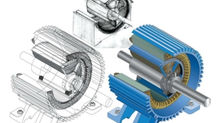Testing and commissioning procedure for electric motors

Testing and Commissioning Procedure For Motors // Photo by TECO Middle East (TME)
Scope Of Motor Testing
It should be noted that the scope of motor testing depends upon the motor type and size, this being indicated on the inspection forms.
Motor vibration shall be measured in a tri-axial direction, i.e.:
Point x axis – side of bearing housing at shaft height
Point y axis – top of bearing housing
Point z axis – axial of bearing housing at shaft height
The measurements shall be carried out with an instrument conforming to ISO 2954 (10-1000 Hz frequency range). With the motor at normal operating temperature, the vibration velocity shall not exceed 2.8 mm/s RMS, or 4 mm/s PEAK, in any direction.
For bearings fitted with proximity probes, the unfiltered peak-to-peak value of vibration (including shaft ‘run-out‘) at any load between no load and full load, shall not exceed the following values:
50 µm for two-pole motors
60 µm for four-pole motors
75 µm for six-pole or higher motors

Motor bearing (photo by CCLW INTERNATIONAL)
Bearing temperature rise limits following a ‘heat run’ of 3.5 – 4 hours are as follows:
Rolling bearings:
Outer ring measurement max. 90 °C
Temperature rise from ambient max. 50 °C
Sleeve bearings:
Oil temperature max. 90 °C
Bearing temperature rise by RTD max. 50 °C
Lub. oil temperature rise from ambient max. 30 °C (for forced lub. oil systems).
When commissioning or re-commissioning motors, precautions shall be taken to avoid excessive vibration caused by the phenomenon known as ‘soft foot‘; i.e. feet which do not have solid flat contact with the base prior to the tightening of the holding-down bolts.
This may be measured and rectified during installation or detected during running by the loosening of each holding-down bolt in turn while measuring motor vibration.
Motor ‘Soft Foot’ Condition
‘Soft feet’ are those which do not have solid flat contact with the base prior to the tightening of the holding-down bolts; one or more feet may be ‘soft’ as shown in Figures 1 to 3.
The profile of the foot contact area may be as shown in Figures 4 to 6.

The profile of the foot contact area (Figures 1, 2 and 3)
Figure 1 – Machine resting on 3 feet, foot 4 is raised or ‘soft’
Figure 2 – Machine resting on diagonal formed by feet 3 and 4, feet 1 and 4 are ‘soft’
Figure 3 – Bottoms of all 4 feet are not parallel with base, feet 3 and 4 are ‘soft’

Profile of ‘soft foot’ contact area
NOTE: Re-machining of rotor feet is required in Figures 4 and 5; temporary use of wedge-shaped shims may be acceptable (maintenance)
Forms:
Form 14 – Inspection of electric motor – Cage-induction type (incl. control unit)

Form 4 – Inspection of Switching Units – HV Switchgear

Form 11 – Inspection Of Outgoing Unit – LV Switchboard

Reference: Field Commissioning and Maintenance Of Electrical Installations and Equipment Manual































